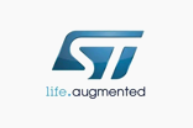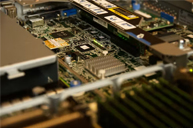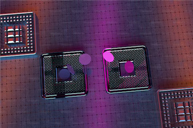Welcome to GoldSource Technology!
 +1 302-669-9600
+1 302-669-9600
Apple's Lab on a Chip has been made public for the first time
3/9/2023 11:13:53 AM
Tencent technology news According to foreign media reports, in the past
20 years, Apple's stock price has been soaring under the drive of a
number of flagship consumer electronic devices. These devices range from
the original iPods and iMacs to later iphones and ipads, and more
recently, Apple Watch smartwatches and AirPods headphones.
But as the most valuable technology giant in the United States, Apple's business is not just about consumer electronics, it has a lot of other things. In a nondescript room at Apple's Silicon Valley headquarters are a few hundred buzzing machines and a few engineers in white lab coats who are designing the self-developed chips that power Apple's most popular products.
Photo: Apple chip executive Johnny Sruji (right) leads reporters on a tour of chip experiments
As early as 2010, Apple for the first time in the iPhone 4 equipped with self-developed chips. Until this year, all new Macs used Apple's own chips, ending the company's 15-year reliance on Intel.
John Ternus, Apple's head of hardware engineering, said: "One of the most profound changes at Apple over the last 20 years has been to develop more technology in-house, starting with chips, of course."
The change also creates a new set of risks for Apple. Its most advanced chips are mostly made by TSMC. At the same time, smartphones are recovering from a sharp decline in sales, while rivals such as Microsoft are making huge leaps in artificial intelligence.
In November, CNBC reporters visited Apple's campus in Cupertino, California, where they were among the first journalists allowed to film in the company's lab-on-a-chip. They took the rare opportunity to talk with Johny Srouji, the head of Apple's chip business, about the company's foray into the complex world of custom chips. At present, Amazon, Google, Microsoft and Tesla and other giants, are also developing their own chips.
"We have thousands of engineers," Sruji says. But if you look at our chip portfolio, we're actually very lean and more efficient."
Unlike traditional chipmakers, Apple does not make chips for other companies. Sruji explained: "Because we don't really sell chips, we can focus more on the product itself. This gives us the freedom to optimize indefinitely, and the scalable architecture allows us to reuse components across different products."
The 01 iPhone has used a self-developed chip since 2010
Sruji joined Apple in 2008 to lead a small team of 40 or 50 engineers designing custom chips for the iPhone. Just a month after he joined, Apple paid $278 million for P.A. Semiconductor, a 150-employee startup.
Ben Bajarin, CEO and principal analyst at consulting firm Creative Strategies, said: "Apple will start making its own chips, which is an immediate benefit from their purchase of P.A. Semiconductor. With its inherent design focus, Apple wants to control as much of the stack as possible."
Two years after the acquisition, Apple used its first self-developed chip, the A4, in the iPhone 4 and the original iPad. Sruji said, "We built what we call a unified memory architecture, which can scale across products. We built an architecture that started with the iPhone and then extended it to the iPad, the smartwatch, and the Mac."
Apple's chip team has grown to include thousands of engineers working in LABS around the world, including Israel, Germany, Austria, the United Kingdom and Japan. In the United States, Apple has experimental facilities in Silicon Valley, San Diego and Austin, Texas.
The main type of chip Apple is developing is called system-on-chip (SoC). Bajarin explained that it combines a central processing unit (CPU), graphics processing unit (GPU), and other components. For Apple, there's also a special neural processing unit (NPU) called the "Running Neural Engine."
Apple's first SoC product was the A Series, which was upgraded from the A4 in 2010 to the A17 Pro released in September this year. The chip is the central processing unit in iphones, some ipads, Apple's set-top box Apple TV, and its smart speaker HomePod. Apple's other major SoC product is the M Series, first released in 2020 and now supporting all new Macs and the more advanced iPad, which has been upgraded to the M3 series.
Apple introduced the S-Series chip in 2015, which is a smaller chip package system for Apple's smartwatch. In addition, Apple uses H and W series chips in AirPods. The U-series chips enable communication between Apple devices. The latest R1 chip will be included in Apple's hybrid Vision Pro headset early next year. Apple says it will process input from the device's camera, sensors and microphone within 12 milliseconds to stream images to the display.
"We can design the chip in advance," says Mr Sruji. He added that his staff worked with a team led by hardware chief Tenus to "precisely and accurately build chips for those products, and only those products."
For example, the H2 chip built into the second-generation AirPods Pro can better eliminate noise. Inside the new Series 9 Apple Watch, the S9 supports new features like double-tap gestures. In the iPhone, the 2017 A11 Bionic is Apple's first neural engine, a dedicated part of the SoC dedicated to performing AI tasks on the device.
The iPhone 15 Pro and iPhone 15 Pro Max, released in September, feature the latest A17 Pro, making major leaps forward in features such as computational photography and advanced rendering of games.
Kaiann Drance, who is in charge of iPhone marketing, said: "This is actually the biggest redesign of GPU architecture and Apple's chip history. We've achieved hardware-accelerated ray tracing for the first time. We also have grid coloring acceleration, which allows game developers to create some truly stunning visuals."
This prompted Ubisoft's Assassin's Creed Mirage, The Division: The Division Resurgence followed by CAPCOM's Resident Evil 4 on the iPhone.
Apple says the A17 Pro will be the first 3-nanometer chip to reach mass production. Sruji said, "The reason we used the 3-nanometer process is that it allows us to pack more transistors in a given size. This is important for the product, and it improves energy efficiency. Even though we're not a chip company, it makes sense that we're leading in this industry."
02 Replace the Intel processor on Mac computers
Apple announced M3 chips for Mac computers in October, continuing its march towards 3nm. The company says the M3 has 22 hours of battery life and, similar to the A17 Pro, improved graphics performance.
"It's too early to call it a success, we still have a lot of work to do, but I think there are a lot of Macs out there, almost all of them, capable of running AAA games, which is a very different situation than five years ago," said Turnus, a hardware executive who has been at Apple for 22 years.
In the beginning, Tenus says, "the way we built products was often to use other companies' technologies and effectively build products around those technologies." Despite the greater focus on aesthetically pleasing design, we are very constrained by existing conditions."
In 2020, Apple dropped Intel's PC processors in favor of using its own M1 chip in the MacBook Air and other Macs, a major shift in the semiconductor industry.
"It's almost like the laws of physics have changed," Tenus explains. All of a sudden, we can make a MacBook Air that is incredibly thin and light, with no fan, up to 18 hours of battery life, and outperforms the MacBook Pro we just launched."
"The latest MacBook Pro with M3 Max, Apple's most advanced chip, is 11 times faster than the MacBook Pro we made at the time with Intel's fastest processor," he added. Just two years ago, we were shipping Intel computers in large quantities."
Intel processors are based on the x86 architecture, which is the traditional choice of PC makers and for which much software has been developed. And Apple's processors are based on the architecture of Intel rival Arm, which is known for helping laptops use less power and last longer.
Apple's M1 series of chips launched in 2020 was a turning point in the adoption of ARM-based processors in high-end computers, competing with other big-name companies such as Qualcomm, AMD, and Nvidia, which are also developing ARM-based PC processors. In September, Apple extended its deal with Arm until 2040.
When Apple introduced its first custom chip 13 years ago, it stood out as a non-chip company trying to gain a foothold in the highly competitive and costly semiconductor market. Since then, Amazon, Google, Microsoft and Tesla have all started experimenting with custom chips.
Stacy Rasgon, managing director and senior analyst at Bernstein Research, said: "Apple can be called a trailblazer in a way. Their actions show that if you do that, you can try to make your product different."
But as the most valuable technology giant in the United States, Apple's business is not just about consumer electronics, it has a lot of other things. In a nondescript room at Apple's Silicon Valley headquarters are a few hundred buzzing machines and a few engineers in white lab coats who are designing the self-developed chips that power Apple's most popular products.
Photo: Apple chip executive Johnny Sruji (right) leads reporters on a tour of chip experiments
As early as 2010, Apple for the first time in the iPhone 4 equipped with self-developed chips. Until this year, all new Macs used Apple's own chips, ending the company's 15-year reliance on Intel.
John Ternus, Apple's head of hardware engineering, said: "One of the most profound changes at Apple over the last 20 years has been to develop more technology in-house, starting with chips, of course."
The change also creates a new set of risks for Apple. Its most advanced chips are mostly made by TSMC. At the same time, smartphones are recovering from a sharp decline in sales, while rivals such as Microsoft are making huge leaps in artificial intelligence.
In November, CNBC reporters visited Apple's campus in Cupertino, California, where they were among the first journalists allowed to film in the company's lab-on-a-chip. They took the rare opportunity to talk with Johny Srouji, the head of Apple's chip business, about the company's foray into the complex world of custom chips. At present, Amazon, Google, Microsoft and Tesla and other giants, are also developing their own chips.
"We have thousands of engineers," Sruji says. But if you look at our chip portfolio, we're actually very lean and more efficient."
Unlike traditional chipmakers, Apple does not make chips for other companies. Sruji explained: "Because we don't really sell chips, we can focus more on the product itself. This gives us the freedom to optimize indefinitely, and the scalable architecture allows us to reuse components across different products."
The 01 iPhone has used a self-developed chip since 2010
Sruji joined Apple in 2008 to lead a small team of 40 or 50 engineers designing custom chips for the iPhone. Just a month after he joined, Apple paid $278 million for P.A. Semiconductor, a 150-employee startup.
Ben Bajarin, CEO and principal analyst at consulting firm Creative Strategies, said: "Apple will start making its own chips, which is an immediate benefit from their purchase of P.A. Semiconductor. With its inherent design focus, Apple wants to control as much of the stack as possible."
Two years after the acquisition, Apple used its first self-developed chip, the A4, in the iPhone 4 and the original iPad. Sruji said, "We built what we call a unified memory architecture, which can scale across products. We built an architecture that started with the iPhone and then extended it to the iPad, the smartwatch, and the Mac."
Apple's chip team has grown to include thousands of engineers working in LABS around the world, including Israel, Germany, Austria, the United Kingdom and Japan. In the United States, Apple has experimental facilities in Silicon Valley, San Diego and Austin, Texas.
The main type of chip Apple is developing is called system-on-chip (SoC). Bajarin explained that it combines a central processing unit (CPU), graphics processing unit (GPU), and other components. For Apple, there's also a special neural processing unit (NPU) called the "Running Neural Engine."
Apple's first SoC product was the A Series, which was upgraded from the A4 in 2010 to the A17 Pro released in September this year. The chip is the central processing unit in iphones, some ipads, Apple's set-top box Apple TV, and its smart speaker HomePod. Apple's other major SoC product is the M Series, first released in 2020 and now supporting all new Macs and the more advanced iPad, which has been upgraded to the M3 series.
Apple introduced the S-Series chip in 2015, which is a smaller chip package system for Apple's smartwatch. In addition, Apple uses H and W series chips in AirPods. The U-series chips enable communication between Apple devices. The latest R1 chip will be included in Apple's hybrid Vision Pro headset early next year. Apple says it will process input from the device's camera, sensors and microphone within 12 milliseconds to stream images to the display.
"We can design the chip in advance," says Mr Sruji. He added that his staff worked with a team led by hardware chief Tenus to "precisely and accurately build chips for those products, and only those products."
For example, the H2 chip built into the second-generation AirPods Pro can better eliminate noise. Inside the new Series 9 Apple Watch, the S9 supports new features like double-tap gestures. In the iPhone, the 2017 A11 Bionic is Apple's first neural engine, a dedicated part of the SoC dedicated to performing AI tasks on the device.
The iPhone 15 Pro and iPhone 15 Pro Max, released in September, feature the latest A17 Pro, making major leaps forward in features such as computational photography and advanced rendering of games.
Kaiann Drance, who is in charge of iPhone marketing, said: "This is actually the biggest redesign of GPU architecture and Apple's chip history. We've achieved hardware-accelerated ray tracing for the first time. We also have grid coloring acceleration, which allows game developers to create some truly stunning visuals."
This prompted Ubisoft's Assassin's Creed Mirage, The Division: The Division Resurgence followed by CAPCOM's Resident Evil 4 on the iPhone.
Apple says the A17 Pro will be the first 3-nanometer chip to reach mass production. Sruji said, "The reason we used the 3-nanometer process is that it allows us to pack more transistors in a given size. This is important for the product, and it improves energy efficiency. Even though we're not a chip company, it makes sense that we're leading in this industry."
02 Replace the Intel processor on Mac computers
Apple announced M3 chips for Mac computers in October, continuing its march towards 3nm. The company says the M3 has 22 hours of battery life and, similar to the A17 Pro, improved graphics performance.
"It's too early to call it a success, we still have a lot of work to do, but I think there are a lot of Macs out there, almost all of them, capable of running AAA games, which is a very different situation than five years ago," said Turnus, a hardware executive who has been at Apple for 22 years.
In the beginning, Tenus says, "the way we built products was often to use other companies' technologies and effectively build products around those technologies." Despite the greater focus on aesthetically pleasing design, we are very constrained by existing conditions."
In 2020, Apple dropped Intel's PC processors in favor of using its own M1 chip in the MacBook Air and other Macs, a major shift in the semiconductor industry.
"It's almost like the laws of physics have changed," Tenus explains. All of a sudden, we can make a MacBook Air that is incredibly thin and light, with no fan, up to 18 hours of battery life, and outperforms the MacBook Pro we just launched."
"The latest MacBook Pro with M3 Max, Apple's most advanced chip, is 11 times faster than the MacBook Pro we made at the time with Intel's fastest processor," he added. Just two years ago, we were shipping Intel computers in large quantities."
Intel processors are based on the x86 architecture, which is the traditional choice of PC makers and for which much software has been developed. And Apple's processors are based on the architecture of Intel rival Arm, which is known for helping laptops use less power and last longer.
Apple's M1 series of chips launched in 2020 was a turning point in the adoption of ARM-based processors in high-end computers, competing with other big-name companies such as Qualcomm, AMD, and Nvidia, which are also developing ARM-based PC processors. In September, Apple extended its deal with Arm until 2040.
When Apple introduced its first custom chip 13 years ago, it stood out as a non-chip company trying to gain a foothold in the highly competitive and costly semiconductor market. Since then, Amazon, Google, Microsoft and Tesla have all started experimenting with custom chips.
Stacy Rasgon, managing director and senior analyst at Bernstein Research, said: "Apple can be called a trailblazer in a way. Their actions show that if you do that, you can try to make your product different."
Blog Category
NewsTags
Related Information
-
Tel
+1 302-669-9600





